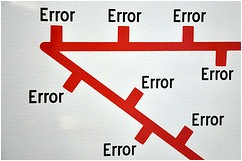Overview of Error Analysis
What is an error?
An error is a form in learner language that is inaccurate, meaning it is different from the forms used by competent speakers of the target language. For example, a learner of Spanish might say "Juana es *bueno," which is not what competent speakers of Spanish would say. The accurate form should be "buena."What is error analysis?
 Error analysis is a method used to document the errors that appear in learner language, determine whether those errors are systematic, and (if possible) explain what caused them. Native speakers of the target language (TL) who listen to learner language probably find learners' errors very noticeable, although, as we shall see, accuracy is just one feature of learner language.
Error analysis is a method used to document the errors that appear in learner language, determine whether those errors are systematic, and (if possible) explain what caused them. Native speakers of the target language (TL) who listen to learner language probably find learners' errors very noticeable, although, as we shall see, accuracy is just one feature of learner language.
While native speakers make unsystematic 'performance' errors (like slips of the tongue) from time to time, second language learners make more errors, and often ones that no native speaker ever makes. An error analysis should focus on errors that are systematic violations of patterns in the input to which the learners have been exposed. Such errors tell us something about the learner's interlanguage, or underlying knowledge of the rules of the language being learned (Corder, 1981, p. 10).
How to do an error analysis
Although some learner errors are salient to native speakers, others, even though they’re systematic, may go unnoticed. For this reason, it is valuable for anyone interested in learner language to do a more thorough error analysis, to try to identify all the systematic errors. This can help researchers understand the cognitive processes the learner is using, and help teachers decide which might be targeted for correction. Researchers have worked out the following procedure for doing an error analysis Corder (1975).1. Identify all the errors in a sample of learner language
For each error, what do you think the speaker intended to say, and how they should have said it? For example, an English learner may say, "*He make a goal." This is an error. However, what should the learner have said? There are at least two possible ways to reconstruct this error: (1) He MAKES a goal, and (2) He IS MAKING a goal. In this first step of an error analysis, remember that there may be more than one possible way to reconstruct a learner error. Tarone & Swierzbin (2009, p.25) offer another example from an English language learner:Learner: …*our school force us to learn English because um it’s, it’s a trend.
Here are three different possible reconstructions:
- Our school forced us to learn English because it was a trend.
- Our school required us to learn English because it was a popular language.
- Because everyone felt it was important, English was a requirement at our school.
The way you reconstruct a learner error depends on what you think the intended message is. An added complication is that any given learner utterance may contain errors at many levels at once: phonological, morphological, syntactic, lexical.
Finally, determine how systematic the error is. Does it occur several times, or is it just a performance slip (a mistake)? Even native speakers of a language make one-off mistakes when they're tired or distracted.
2. Explain the errors
Once you've identified systematic errors in your sample of learner language, think of what might have caused those errors. There are several possibilities. Some errors could be due to native language transfer (using a rule or pattern from the native language). Some could be developmental—errors most learners make in learning this language no matter what their native language. Induced errors may be due to the way a teacher or textbook presented or explained a given form. Communication strategies may be used by the learner to get meaning across even if he or she knows the form used is not correct (Selinker 1972 discusses these and other possible causes of systematic learner errors). Explaining errors in learner language isn't always straightforward; for example, sometimes an error may appear to have more than one cause. As Lightbown & Spada (2013, p. 45) say, "... while error analysis has the advantage of describing what learners actually do … it does not always give us clear insights into why they do it."What error analysis misses
Error analysis is a good first step, but it also can miss important features of learner language. First, in focusing only on errors, you may miss cases where the learner uses the form correctly. For example, you may notice that a learner makes errors in pronouncing a TL sound before consonants, but not notice that she is producing the sound correctly before vowels. The second thing an error analysis misses is avoidance. Schachter (1976) pointed out that learners can avoid using features of a TL that they know they have difficulty with. For example, you may see very few errors in relative clauses in a sample of English learner language, but then realize that's because the learner simply isn't producing many relative clauses—correct OR incorrect. Avoidance can lead to the absence of errors—but absence of errors in this case does NOT mean the learner has no problems with relative clauses. Finally, error analysis focuses only on accuracy. Accuracy is just one of three ways of describing learner language: accuracy, complexity and fluency. If teachers judge learner language only in terms of accuracy, the learners' development of complexity and fluency can suffer. (See the section on Complexity)Learning more
To learn more about error analysis, we recommend that you read Chapters 3 and 4 in Ellis and Barkhuizen (2005).Multimedia Activities focused on Learner Characteristics
Graphic used with Creative Commons permission, from:
http://www.flickr.com/photos/nickwebb/3016498475/sizes/s/
